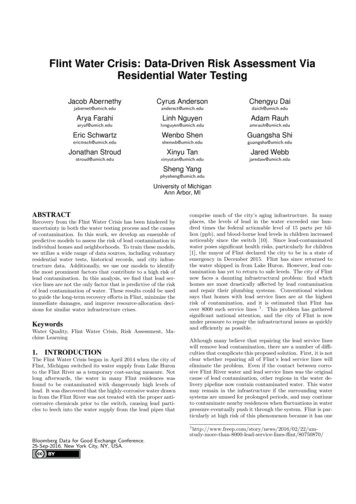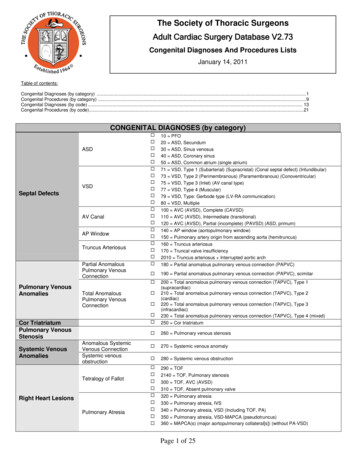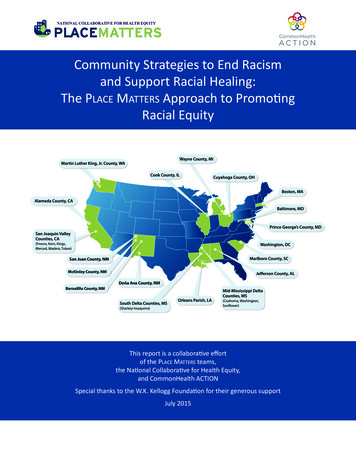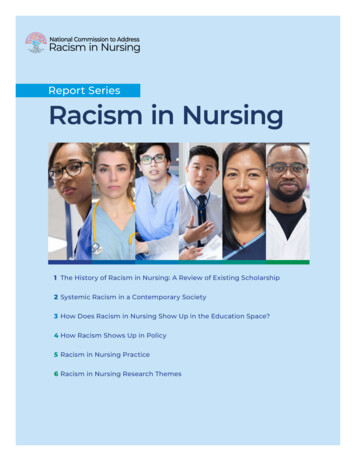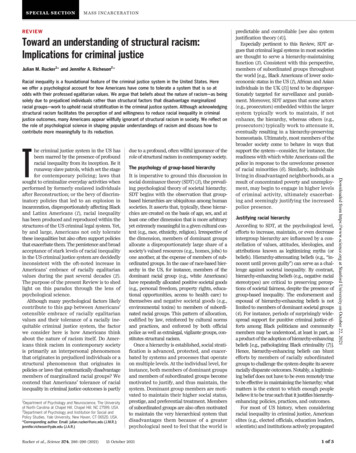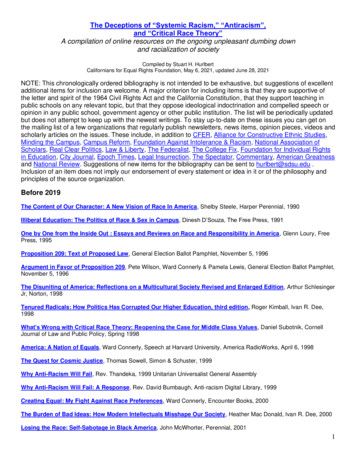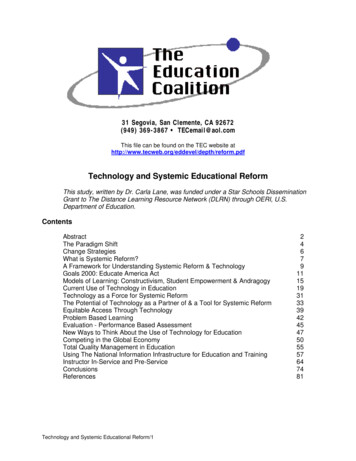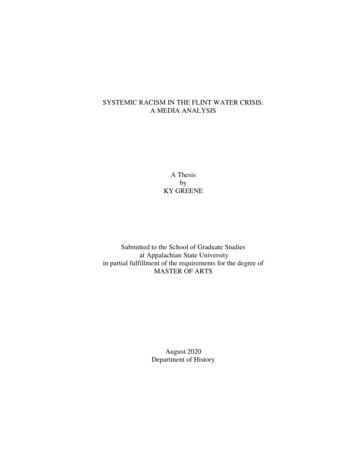
Transcription
SYSTEMIC RACISM IN THE FLINT WATER CRISIS:A MEDIA ANALYSISA ThesisbyKY GREENESubmitted to the School of Graduate Studiesat Appalachian State Universityin partial fulfillment of the requirements for the degree ofMASTER OF ARTSAugust 2020Department of History
SYSTEMIC RACISM IN THE FLINT WATER CRISIS:A MEDIA ANALYSISA ThesisbyKY GREENEAugust 2020APPROVED BY:Andrea Burns, Ph.D.Chairperson, Thesis CommitteeAnastacia Schulhoff, Ph.D.Member, Thesis CommitteeAntonio T. Bly, Ph.D.Member, Thesis CommitteeJames Goff, Ph.D.Chairperson, Department of HistoryMike McKenzie, Ph.D.Dean, Cratis D. Williams School of Graduate Studies
Copyright by Ky Greene 2020All Rights Reserved
AbstractSYSTEMIC RACISM IN THE FLINT MEDIA CRISIS:A MEDIA ANALYSISKy GreeneB.A., Appalachian State UniversityChairperson: Dr. Andrea BurnsAn analysis of the media coverage of the Water Crisis in Flint, Michigan fromApril 2014 to January 2016 revealed that the news coverage of the crisis served toreinforce the white racial hegemony of 21st century America. In the Introduction, Iprovide a general overview of the contents of the thesis. In Chapter One, I sketch anoutline of the colorblind paradigm I constructed as an analytic model using thetheories of Joe R. Feagin, Eduardo Bonilla-Silva, and Cedric C. Clark. I then applythat model to four types of media – advertisements, sports, reality television, andnews media – to demonstrate how the media perpetuates and reinforces white racialhegemony. In Chapter Two, I provide a historical sketch of Flint, Michigan and theevents that led to the Flint Water Crisis. In Chapter Three, I apply the colorblindparadigm to the media coverage of the Flint Water Crisis to underscore theprevalence of white racial hegemony within the coverage of the event. Finally, in theConclusion, I offer potential avenues for future research.iv
AcknowledgmentsI would like to thank my thesis committee members, Dr. Andrea Burns, Dr. AnastaciaSchulhoff, and Dr. Antonio T. Bly for their willingness to work with me on a project thatblends the fields of history, public history, and sociology. Dr. Burns provided me withexcellent insight into how to improve my writing and her background as a Flint native hasbeen invaluable over the course of this project. Dr. Schulhoff led me to sociological sourcesthat I may have otherwise overlooked, and her guidance has allowed me to engage deeplywith race and the problems of systemic racism within the United States. Dr. Bly gave mecritical insight into African American history and culture that helped me discern rhetoricalpatterns of colorblind racism that I may have otherwise overlooked.I would also like to thank the Appalachian State University Library, as the ability toaccess the interlibrary loan system and the online databases provided me with the researchmaterials I needed. In addition, I would like to thank all the graduate professors in theHistory Department of Appalachian State for all the support they have given me over the lasttwo years. Lastly, I would like to thank Renee Gamble and Donna Davis, whose presenceand conversation helped decrease the stress that any large writing project entails. Theirencouragement and understanding eased my anxiety and helped me push through the hardestdays of writing.v
Table of ContentsAbstract . ivAcknowledgments.vIntroduction .1Chapter One: The Colorblind Paradigm Applied to Media Analyses .24Chapter Two: The Racial Reality of Flint and the Water Crisis .58Chapter Three: The Colorblind Paradigm Applied to the Flint Water Crisis .80Conclusion: Future Research and Historiography .98Bibliography .120Appendix A: List of All News Articles Consulted .131Vita.139vi
IntroductionThe ideology of colorblindness asks people not to see color, not to notice race. Ratherthan dismantling racial barriers, however, the ideology of colorblindness serves as thelynchpin of white dominance because it “reinforces whiteness as the unmarked norm againstwhich difference is measured.”1 Colorblind ideology prevents engagement with the societalstructures that privilege whiteness by denying that any such structures exist. According toGeorge Lipsitz, a professor in the Department of Black Studies at the University ofCalifornia, the ideology of colorblindness requires historical fiction. He argues that the veryidea that colorblind racism has only existed since the Civil Rights Movement is itself anahistorical idea that serves to reinforce the hegemony of white supremacy, which colorblindideology undergirds. Lipsitz claims, “The falsifications of history central to colorblindnessattribute conquest, colonization, slavery, segregation, and immigrant exclusion to the merefact of racial recognition rather than to carefully constructed structures of racial rule.”2Lipsitz explains that the manner of dispossession Europeans and European Americansforced on the indigenous peoples of the Americas originated from a refusal to recognize thatPeople of Color were human. Lipsitz also states that the nature of dispossession the nativepeoples were subject to relied on “not seeing” due to the fictional nature of legal ideas like“terra nullius” that claimed that lands possessed by native tribes sat empty just waiting forEuropeans to come along and claim the land for themselves.3Lipsitz demonstrates that even the founding documents of the country held colorblindideology. He discusses the three-fifths clause and the fact that the Constitution neverGeorge Lipsitz, “The Sounds of Silence: How Race Neutrality Preserves White Supremacy” in Seeing RaceAgain: Countering Colorblindness across the Disciplines (University of California Press: California, 2019), 24.2Ibid,” 25.3Ibid,” 25. Italics in original.1-1-
explicitly mentioned slaves or African Americans, but in the social context of the time,everyone would have understood whom the three-fifths clause referenced. This held true forthe fugitive slave clause baked into the Constitution that required the federal government toreturn runaway slaves to their owners, and it also held true for the clause that protected theslave trade up until 1808 under the guise of permissible migration.4Among race scholars, Lipsitz is one of the few that posits that colorblind racism hasalways existed within the United States. He illuminates the existence of colorblind ideologythroughout the Jim Crow era, an era often viewed as one of the most overtly racist inAmerican history. The 15th Amendment ensured that African American men could vote, butmany states had grandfather clauses that ensured only individuals whose grandfathers hadbeen eligible to vote could vote. Despite the lack of an explicit reference to race, theseclauses often prevented African American men from voting because many of them hadgrandfathers who had been slaves who did not have the right to vote. Even though thegrandfather clauses were colorblind because they did not specify race, they worked todisenfranchise African American men. With examples such as these, Lipsitz’s argument is ahard one to refute, and it raises the question as to why so many race scholars insist that theideology of colorblind racism originated in the 20th century.5While colorblind racism may have penetrated the Constitution and other legaldocuments within the United States, it may also safely be argued that it did not become thedominant racial ideology espoused by society until the 1970s.6 The concept that thesignificance of race within society decreased after the Civil Rights Movement originated with4Ibid, 26-27.Ibid,” 28.6Bonilla-Silva, Racism without Racists: 26.5-2-
William Julius Wilson’s 1980 publication of The Declining Significance of Race: Blacks andChanging American Institutions. In a 2011 article meant to update readers, Wilson explainsthat the argument he had been trying to make in The Declining Significance of Race was thatsocioeconomic status became more important than race in determining someone’s lifechances after World War II during the modern industrial period.7In Colorblind: The Rise of Post-Racial Politics and the Retreat from Racial Equity(2010), activist and race scholar Tim Wise examines the myth of a post-racial society thatbecame a popular narrative after Barack Obama, an African American man, secured theposition of the President of the United States in 2008. Wise discusses how President Obamaused the “rhetoric of racial transcendence” in his pursuit of the presidency to mitigate thefears of white voters.8 The rhetoric President Obama may have helped him secure whitevotes, but it also made it more difficult for him to address societal issues pertaining to race.Wise discusses how the rhetoric of a so-called “post-racial” society serves to disguise notonly the existence of structural racism within the United States but also serves to hide itsextent.Regardless of when colorblind racism became the dominant racial ideology of theUnited States, the ideology of colorblind racism pervades the country today. The completionof the Human Genome Project in 2003 established that race is a socially constructedcategory, as there is no genetic difference between racial groups.9 Because race is a societallyWilliam Julius Wilson, “The Declining Significance of Race: Revisited & Revised,” Daedalus Vol. 140, No. 2(2011): 56.8Tim Wise, “Colorblind: The Rise of Racial Politics and the Retreat from Racial Equity,” (San Francisco: CityLight Books, 2010), 16.9Jinny Huh, “Race in Progress, No Passing Zone: Battlestar Galactica, Colorblindness, and the Maintenance ofRacial Order,” in The Colorblind Screen (New York University Press: New York, 2014), 325-326.7-3-
constructed concept, and because it is not a “real” category, it is easier for whites to deny thepower and influence of race in the current colorblind era.Elaine A. Robinson, a professor of Methodist studies and Christian theology at theSaint Paul School of Theology, references Anthony Appiah’s threefold structure of collectiveidentities to explain how collective identities like race are socially constructed. Appiah’sthreefold structure of a socially constructed collective identity begins with public discoursethat builds labels around specific characteristics about a distinct group of people. From there,the people within that group start to recognize those labels as part of their identity. Finally,people outside the group develop patterns of behavior towards both the labels and the groupthey are applied to that then becomes the type of treatment members of a specific collectiveidentity receives. In this way, collective identities such as race and gender are sociallyconstructed.10While race is a social construction, it has a very real impact on the lives of People ofColor. Those who are considered racially marginalized within the United States have nodifficulty seeing the societal disadvantages race creates for them, while white individualsoften deny accusations of racial discrimination that arise. Rather than acknowledging thatthere are structural and systemic issues within the United States, many whites prefer to blamespecific individuals or groups for structural issues in a way that ignores race. The denial of aracial component to the structural issues within the United States is what scholars of racerefer to as “’colorblind racism,’ ‘racial realism,’ and ‘modern racism.’”11Elaine A. Robinson, “Whiteness: The Structure of Institutional Racism,” in Moral Issues and ChristianResponses, ed. Patricia Beattie Jung and L. Shannon Jung, (Augsburg Fortress Publishers: Nashville, 2013),227-228.11Robinson, “Whiteness: The Structure of Institutional Racism,” 228.10-4-
According to Elaine A. Robinson, colorblind racism contains a few key centralassumptions about race. The first assumption made by those who adhere to the ideology ofcolorblindness is that the civil rights legislation of the Civil Rights Movement of the 1960shas been so successful that racism and racial inequalities have been eradicated, althoughthere are still pockets of individuals who act from a racist vantage point. A secondassumption made by those who adhere to the ideology of colorblindness is that there is alevel playing field in society, so everyone – regardless of race – has equal access to societalresources and opportunities. These two assumptions logically lead to the third assumptionadherents of colorblindness make—failure in society is due to individual or culturalcharacteristics of specific people or racial groups who fail to take advantage of theopportunities that arise. For this reason, colorblind racism can also be referred to as “culturalracism,” as adherents of the ideology presume that there are cultural characteristics andpersonality traits that prevent people from succeeding.12One of the seminal titles in the field of race theory is Michael Omi and HowardWinant’s book, Racial Formation in the United States: From the 1960s to the 1990s(1994).13 Omi and Winant’s monograph provides an overview of how the U.S. transitioned toa society built on the idea of colorblindness from the 1960s to the 1980s as well as a critiqueof race theory that they say tends to decentralize race in favor of ethnicity and nationality.The main argument that Omi and Winant make in their work is that race plays a central roleat all levels of U.S. society, and that “Race will always be at the center of the Americanexperience.”14Robinson, “Whiteness: The Structure of Institutional Racism,” 228.The first edition was published in 1986, then updated in 1994.14Michael Omi and Howard Winant, Racial Formation in the United States: From the 1960s to the 1990s,(Routledge: London, 1994), 5. Emphasis in original.1213-5-
Another prominent race scholar is Eduardo Bonilla-Silva, the author of several booksand articles on race theory. Racism Without Racists: Colorblind Racism and the Persistenceof Racial Inequality in the United States (2014) serves as one of the primary references oncolorblind rhetoric for the arguments in this paper. In Racism without Racists, Bonilla-Silvacompiled data from 627 random interviews taken from the 1997 Survey of Social Attitudesof College Students given to three colleges – one a large Midwestern university, one amedium western united, and one a large southern university. He also used data from eightyfour randomly selected interview samples from the 1998 Detroit Area Study to ensure thedata came from a wider population than just college students. The data he examined allowedhim to extrapolate four central frames of colorblind racism – abstract liberalism,naturalization, cultural racism, and the minimization of racism, which serve as the pillarsused in the construction of colorblind racial ideology.15 Bonilla-Silva also authored the bookWhite Supremacy and Racism in the Post-Civil Rights Era in 2001 where he argues that theUnited States operates from a racialized societal structure in the 2 century.Augmenting that argument is historian Ibram X. Kendi in his work, Stamped from theBeginning: The Definitive History of Racist Ideas in America (2016). Drawing on primarysources from five prominent historical figures—Cotton Mather, Thomas Jefferson, WilliamLloyd Garrison, W.E.B. DuBois, and Angela Davis—Kendi chronicles the racist sentimenttowards African Americans that has pervaded and continues to pervade American society.In their book, American Apartheid: Segregation and the Making of the Underclass (1998),Douglas S. Massey and Nancy Denton illustrate how governmental policies of the 1960sforced African Americans out of white neighborhoods and into dilapidated neighborhoods15Eduardo Bonilla-Silva, Racism without Racists, 12, 74.-6-
that quickly became predominantly filled with impoverished African Americans and createdthe phenomena of hypersegregation. Despite laws against segregation, the practice ofrestrictive neighborhood covenants and redlining ensured that African Americans remainedsegregated. Even after the 1968 Fair Housing Act passed, realtors often used (and still use)underhanded techniques to restrict the access African Americans had (and have) to property.Massey and Denton’s monograph provides valuable insight into the structural inequalitiesAfrican Americans contend with in their everyday lives.Those structural inequalities lead to the school-to-prison pipeline that MichelleAlexander discusses in her book, The New Jim Crow: Mass Incarceration in the Age ofColorblindness (2010). She highlights the racial order of 21st century America, arguing thatthe criminal justice system in the United States functions as a system of racial controlbecause a disproportionate number of African Americans and other People of Color areincarcerated in comparison to white individuals. Ava DuVernay, the filmmaker behind thedocumentary “13th (2016),” continues Alexander’s line of argumentation further. In thedocumentary, she makes it clear that the 13th amendment features a loophole that allows theU.S. government to use prison labor as slave labor. She rightly points out that the 13thamendment itself does not outlaw slavery entirely; there is a loophole that allows slavery aspunishment for a crime. The combination of DuVernay and Alexander’s argumentsunderscores the troubling reality that the criminal justice system, through a false lens ofcolorblind justice, continues to perpetuate the racial order established during the era ofslavery.In Robert M. Entman and Andrew Rojecki’s book, The Black Image in the WhiteMind (2000), the authors explore the racial patterns embedded in the media portrayal of-7-
African Americans. While the authors do not find that the media actively promotes racism,they do find that the media has embedded within it the subtle implication of a racial hierarchywith whites at the top of the racial order. Entman and Rojecki also find that the media, whilenot actively encouraging racist behavior, does not promote racial cohesion (a.k.a. racialharmony).In contrast to Entman and Rojecki, Dennis Rome finds in his monograph, BlackDemons: The Media’s Depiction of the African American Male Criminal Stereotype (2004)that the media’s perpetuation of the image of African American males as criminalsproliferates throughout society. The proliferation of that image reinforces the stereotype ofAfrican American males as violent, and Rome argues that racism within the United Stateswill exist until the stereotype of the violent black man is eradicated from the media andAmerican society.Like Rome, Jeannette Covington focuses on the negative portrayal of AfricanAmerican individuals in the media. In her work, Crime and Racial Constructions: CulturalMisinformation about African Americans in Media and Academia (2010), Covington findsthat films released after the 1970s often depict African American males as violent andAfrican American females as sexually promiscuous and irresponsible. She then examines theway criminologists have used the stereotypical portrayals of African Americans to link crimeto African Americans.The book, The Racial Contract (1999), penned by philosopher Charles W. Mills,takes John Locke’s social contract theory and illustrates that racism against non-whiteEuropeans is at the heart of Locke’s philosophy. Mills discusses how that hidden racialcontract has created a global racial order that paints whites as persons and non-whites as sub--8-
persons and thus works to justify historical and ongoing exploitation of People of Color bywhite individuals.While Charles W. Mills explores the philosophical implications of the racial contract,sociologist Joe R. Feagin outlines the way systemic racism operates in the United States.Like Bonilla-Silva, Feagin is a prominent race scholar, and most of his books focus ondepicting how systemic racism operates within the United States. That focus is reflected inthe titles of his monographs. Some of Feagin’s works include White Racism: The Basics(1994), Living with Racism: The Black Middle-Class Experience (1994), The Agony ofEducation: Black Students at a White University (1996), Racist America: Roots, CurrentRealities, and Future Reparations (2000), The Many Costs of Racism (2002), White Men onRace: Power, Privilege, and the Shaping of Cultural Consciousness (2003), SystemicRacism: A Theory of Oppression (2006), How Race Has Been Framed in America (2009),and The White Racial Frame: Centuries of Racial Framing and Counter-Framing (2013).In his monograph, Two Nations: Black and White, Separate, Hostile, Unequal (1992),social scientist Andrew Hacker argues that America has largely divided itself into a whiteand black sphere. In the first half of the book, he explores the subjective realities experiencedby both whites and People of Color in American society. In the second half, he usesstatistical evidence to demonstrate the role race plays in several societal spheres, includingthe spheres of education, business, and income. Hacker also explains how white individualsbenefit from this societal division, and states that “No white American, including those whoinsist that opportunities exist for persons of every race, would change places with even the-9-
most successful black American. All white Americans realize that their skin comprises aninestimable asset.”16Continuing the conversation about white privilege are the race scholars David R.Roediger, the author of The Wages of Whiteness: Race and the Making of the AmericanWorking Class (2007), and George Lipsitz in his book, The Possessive Investment inWhiteness: How White People Profit from Identity Politics (2006). Both Roediger and Lipsitzdiscuss how white individuals profit, often invisibly, from the societal disenfranchisement ofPeople of Color. Specifically, Roediger looks at how racism developed in working-classAmerica, fostered on working-class whites by the white bourgeoisie. In contrast, Lipsitzillustrates how white individuals at all levels of society invest in whiteness as a type ofproperty – because whiteness is treated like a property, relinquishing it becomes incrediblydifficult for white individuals.While it is difficult for whites to relinquish the concept of whiteness, it is notimpossible. Richard Dyer, a white media studies scholar, demonstrates through hismonograph, White (1997), that it is not only possible for white individuals to relinquishwhiteness but to also learn how to analyze the racial structure of the United States. For White,Dyer compiled several essays about how white individuals are portrayed in the media as nonraced. As Dyer says it, “The sense of whites as non-raced is most evident in the absence ofreference to whiteness in the habitual speech and writing of white people .This assumptionthat white people are just people, which is not far off saying that whites are people whereasother colours are something else, is endemic to white culture.”1716Andrew Hacker, Two Nations: Black and White, Separate, Hostile, Unequal, (New York: Macmillan, 1992),60.17Richard Dyer, White, (London: Routledge, 1997), 2.- 10 -
Turning to the scholars who have researched the history of Flint. Ronald Edsforthprovides an overview of Flint’s history from 1890 to 1960 in his book, Class Conflict andCultural Consensus: The Making of a Mass Consumer Society in Flint Michigan (1987).18 Heargues that the auto workers of Flint already contained a culture of mass consumption duringthe 1920s and emphasizes the role that consumerism played into integrating auto workersinto the capitalist economy of the United States. In the space of two monographs,Remembering Flint, Michigan: Stories from the Vehicle City (2010) and Hidden History ofFlint (2017), Gary Flinn provides historical anecdotes about Flint and its architecturalhistory, and he includes a fifty-year overview of how the Flint Water Crisis emerged.19Stephen P. Dandanau’s monograph, A Town Abandoned: Flint, Michigan ConfrontsDeindustrialization (1996) discusses how Flint became a deindustrialized city after GeneralMotors stopped operating within its borders and the devastating impact deindustrializationhad.20In his 2012 article, “Beyond Corporate Abandonment: General Motors and thePolitics of Metropolitan Capitalism in Flint, Michigan,” Andrew Highsmith provides a directcounter to Dandaneau’s argument, as he contends that General Motors shifted jobs awayfrom Flint in an effort to create a metropolitan government that would help expand the city.21Highsmith furthers that argument in his monograph, Demolition Means Progress (2015),where he discusses the way that the policies and programs implemented in Flint in an effort18Ronald Edsforth, Class Conflict and Cultural Consensus: The Making of a Mass Consumer Society in FlintMichigan (New Jersey: Rutgers University Press, 1987), 1-294.19Gary Flinn, Remembering Flint, Michigan: Stories from the Vehicle City (Charleston: History Press, 2010), 1195.Gary Flinn, Hidden History of Flint (Charleston, History Press, 2017), 1-179.20Steven P. Dandaneau, A Town Abandoned: Flint, Michigan, Confronts Deindustrialization (Albany: StateUniversity of New York Press, 1996), 1-259.21Andrew Highsmith, “Beyond Corporate Abandonment: General Motors and the Politics of MetropolitanCapitalism in Flint, Michigan” Journal of Urban History, Vol. 40, No. 1 (2012: 31-47.- 11 -
to revitalize the city resulted in its economic and racial fragmentation.22 George Lord andAlbert Price’s argument in their 1992 article, “Growth Ideology in a Period of Decline:Deindustrialization and Restructuring, Flint Style,” predates that of Highsmith’s, but theyalso argue that the growth ideology associated with a need to develop the economyeventually failed and resulted in the deindustrialization of Flint.23Justin Hollander analyzes how population decline impacted Flint, Michigan in his2010 article, “Moving Toward a Shrinking Cities Metric: Analyzing Land Use ChangesAssociated with Depopulation in Flint, Michigan,” while Amy Cantor and John Nysteunevaluated the presence and impact of redlining in Flint in their earlier 1982 article, “De FactoRedlining a Geographic View.”24 The last monograph that pertains specifically to the historyof Flint is the personal memoir of Gordon Young, Teardown: Memoir of a Vanishing City(2013) who moved back to Flint after living in San Francisco for fifteen years. Heinterviewed Flint residents to discover what had changed since he had left, so his memoirsupplies insight into early 2000s Flint.25Because of the relative recency of the Flint Water Crisis, few individuals other thanjournalists, environmental scholars, and activists have offered any analysis of the crisis. Thisis understandable, as many historians are hesitant to engage with events that are still ongoing,as it is difficult to discern the impact any event will have on the future. The journalists whohave analyzed the crisis have tried to provide clear accounts of the origins of the crisis. Thefirst journalist to compile a monograph on the subject was Anna Clark. In her work, The22Andrew Highsmith, Demolition Means Progress (Chicago: University of Chicago Press, 2015), 1-293.Justin B. Hollander, “Moving Toward a Shrinking Cities Metric: Analyzing Land Use Changes Associatedwith Depopulation in Flint, Michigan” Cityscape, Vol. 12, No. 1 (2010): 133-151.24Amy C. Kantor and John D. Nystuen, “De Facto Redlining a Geographic View,” Economic Geography, Vol.58, No. 4 (October 1982): 309-328.25Gordon Young, Teardown: Memoir of a Vanishing City (Berkeley: University of California Press, 2013), 1288.23- 12 -
Poisoned City: Flint’s Water and the American Urban Tragedy (2018), she sketches anoverview of the crisis through viewpoints of the individuals she interviewed.26 Clarkincluded interviews with a variety of people, including individuals who instigated the crisis,people who suffered from the high levels of toxins in the water, and the people who workedto bring the problem to the attention of the state and, eventually, the nation.The pediatrician, Mona Hanna-Attisha, wrote a personal account of the crisis, and shewas one of the many who worked hard to bring the problem to the attention of thegovernment. In her book, What the Eyes Don’t See: A Story of Crisis, Resistance, and Hopein an American City (2018), she discusses how she became part of a group of activists thatrallied against the government to force the truth about the water into the public sphere.27 Thestaff of Bridge Magazine, who compiled information about the crisis in the book, Poison onTap (A Bridge Magazine Analysis): How the Government Failed Flint, and the Heroes whoFought Back (2016).28 Benjamin J. Pauli, a journalist who also worked as an activist in Flint,provides an account of the crisis in his monograph, Flint Fights Back: Environmental Justiceand Democracy in the Flint Water Crisis (2019). He sketches three different narratives of thecrisis - the political, the historical, and the technical narratives - and provides insight into theview the activists themselves held of the crisis as a fight with democracy on the line.29Two government works deal specifically with the crisis, and that is the MichiganCivil Rights Commission (MCRC) report, The Flint Water Crisis: Systemic Racism Throughthe Eyes of Flint
I would like to thank my thesis committee members, Dr. Andrea Burns, Dr. Anastacia Schulhoff, and Dr. Antonio T. Bly for their willingness to work with me on a project that blends the fields of history, public history, and sociology. Dr. Burns provided me with excellent insight into how to improve my writing and her background as a Flint native has


